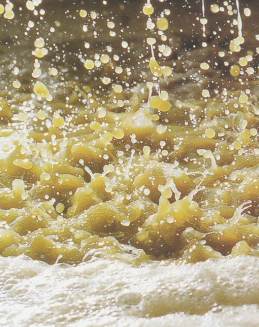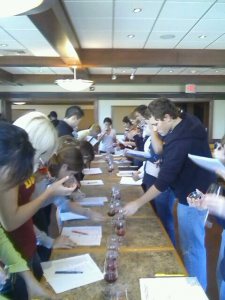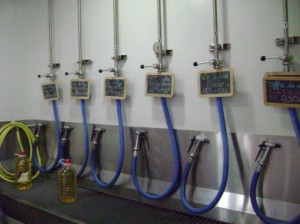Brad Beam’s The Winemaker’s ‘Art”
One of my favorite things about making wine is the constant interaction of art and science; the interplay of data and fact with style, aesthetic, and yes, even romance. Unfortunately, it seems like the promotion of wine to consumers relies pretty heavily on the aesthetic and romantic side of the equation. Old world wineries have become masters at this! Whether or not they truly believe in their own rhetoric is not for me to decide, but every time I hear a reference to the famous Galileo quote, ‘Wine is sunlight, held together by water” to customers, I cringe at the simplification of such a wonderfully complex process. Give your winery some credit! Give your grape growers some acknowledgement!
So, without getting too rant-y, I’d like to discuss the complexity of wine making by breaking it down into its basic components.
1: Grape Growing and Vineyard Management
If Galileo’s quote fits anywhere in the process, it is here. However, to simply plant grapes and let the heavens do the rest is a terrible plan for producing high-quality wine. If you doubt this, take a walk in the woods. The grapevines you’ll encounter will be growing to the top of the forest canopy! Little to no fruit will be found anywhere, and chances are you wouldn’t want to eat/drink it anyway. However, they do make great swinging ropes for kids. The point is that all kinds of decisions must be made in the vineyard to produce the best wine. Based on the example in the image above, this grapevine would present a number of problems commercially (other than that is was cut at ground level by the forest management service).
Namely, it is not a very good selection for wine, and it’s growing on an undesirable site with no trellising or canopy management. These are issues growers and wine makers have to solve from the very beginning: which cultivars to plant on the given site, and how to train and trellis it. Once those issues are resolved, growers and wine makers must then determine which canopy management strategy, pest management program, crop load, and harvest timing will produce the best quality wine. This, on its own, is no small undertaking! Most growers will spend a lifetime fine-tuning their practice. As it is commonly put in the wine industry: great wines begin in the vineyard.
2: Style Choices
The next big decision is what kind of wines to make from the grape varieties to be processed. This may seem simple on the surface, given that most consumers will have a certain expectation of most traditional varietals. For example, a California ‘Chardonnay’ is expected to be a dry, white wine aged in oak. In the Midwest, however, we are generally free of these restrictions. We are currently determining which styles work best for different grapes, as well as which grapes work well in a variety of sites. We have found in Illinois that several of our grapes are quite versatile. ‘Chambourcin’, for example, seems to work well as a dry, oak-aged red, sweet red, rosé, and fortified dessert wine! The decisions on style are largely determined by consumer demand (which styles sell best) as well as the grape variety and site. However, since most of our grape varieties are still pretty new, this will take a long time to fine-tune to the point of industry consensus. This is one of the reasons I personally find Midwest wines so exciting. You can taste five ‘Seyval blanc’ from different producers that are distinctly different from one another. You never know what’s coming up next!
3. Cleaning and Sanitation
Here comes the romance! Ask any reputable wine maker, and they’ll tell you they spend as much (if not more) time cleaning and sanitizing tanks, equipment, and surfaces than actually making wine. The fight against spoilage organisms never ends. Failure to adhere to strict cleaning and sanitation practices can result in wines that smell like barnyard, plastic bandage, fingernail polish remover, and vinegar. Yum.
4. Conducting Fermentation
 From this point forward I tend to think of the role of a wine maker as steward, rather than creator. We don’t make wine. Yeast do that, by converting sugar into alcohol. However, we can help them do the best job possible for the resultant wine. Factors that can be manipulated by the wine maker include yeast strain(s), yeast nutrition, pre-fermentation treatments to juice and must, and competition from other microorganisms. Specific issues that arise include skin contact time for reds, cold-soaking for reds and whites, and the use of pectic enzymes, oak products, and other additives. Each of these decisions is made with the grape variety and desired style in mind.
From this point forward I tend to think of the role of a wine maker as steward, rather than creator. We don’t make wine. Yeast do that, by converting sugar into alcohol. However, we can help them do the best job possible for the resultant wine. Factors that can be manipulated by the wine maker include yeast strain(s), yeast nutrition, pre-fermentation treatments to juice and must, and competition from other microorganisms. Specific issues that arise include skin contact time for reds, cold-soaking for reds and whites, and the use of pectic enzymes, oak products, and other additives. Each of these decisions is made with the grape variety and desired style in mind.
5. Chemical Analysis
Data must be collected during the entire process, starting in the vineyard. Wine makers learn to measure sugars and acids, yeast-available nitrogen, sulfur dioxide concentrations, alcohol, and volatile acidity with equipment and processes that are typically new for producers who lack an academic background in wine production. All of this information is important to help construct a concrete picture of the wine, which aids critical decisions to be made down the road. A great example is the measurement of pH, which is a reflection of wine acidity. Generally, the lower the pH, the higher the acid in the wine. However, the number you receive is not an accurate reflection of the sensory attributes of the wine. A wine with a pH of 3.5 may not necessarily taste more acidic than one with a pH of 3.8. What wine makers know is that pH affects the form in which sulfur compounds will be expressed. Sulfites are added to wines to prevent oxidation and unwanted microbial growth, and are in a more effective form at lower pH. That is, a given amount of sulfite added to wine will do more work at a low pH than at a higher one. So, with this information, a wine maker can decide whether a pH adjustment is necessary, or if they should alter the amount of sulfur dioxide added to the juice or wine. Not knowing the pH could easily result in shortened shelf life of the wine and/or poor quality due to faulty aromas.
6. Sensory Analysis
Thankfully, it takes much more than chemical analysis to make the perfect wine! It is very possible to make a terrible wine that exhibits perfect chemistry. The wine maker’s job is to ensure that the appearance, smell, and taste of the finished product is aesthetically pleasing. Most faults that show up in wine have some sensory impact, whether it shows up as a haze, foul odor, or bitter flavor. Additionally, the senses help us fine-tune the aging process for a wine, particularly for reds. The type of barrel and time the wine spends in contact with oak are largely determined by smell and taste. Every barrel is a little different, so aging times will vary depending on wood source, toast level, and how long the barrel has been used in production. Wine makers constantly experiment with blends, whether it’s related to selecting barrels of wine to blend together or blending multiple varieties together. Blending is wine making, for both red and white wines. It is common for any wine with a varietal label (i.e. ‘Chardonnay’) to have a small percentage of something else blended in to add complexity and balance.
7. Finishing The Product
The chemical and sensory analysis that are conducted help the wine maker make final decisions with the wine. For example, if a white wine is bitter on the palate, the wine maker can add something to pull the bitterness out of the wine. This act is referred to as ‘fining”. Different fining agents can be used to remove bitterness, astringency, hazes, and undesirable color and flavors. During this final phase, the wine maker will correct faults if possible, and ultimately, make the decisions that result in the final product.
Cheers everybody, and congrats to all my wine friends out there on surviving another season!
BB
This article originally appeared on localpouril.wordpress.com and was republished with permission.










The large challenges that could be added to them would mean comprehend to have a good steady in addition to developing a strength professional signage this away from.